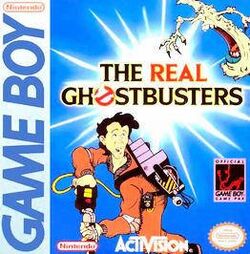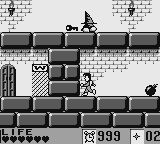Software:The Real Ghostbusters (video game)
| The Real Ghostbusters | |
|---|---|
 North American cover art | |
| Developer(s) | Kemco[1] |
| Publisher(s) | |
| Series | Crazy Castle |
| Platform(s) | Game Boy |
| Release |
|
| Genre(s) | 2D action platformer |
| Mode(s) | Single-player |
The Real Ghostbusters, known in Europe as Garfield Labyrinth and in Japan as Mickey Mouse IV: Mahō no Labyrinth (ミッキーマウスIV 魔法のラビリンス Mikkī Mausu Fō: Mahō no Rabirinsu), is a 1993 action/puzzle video game developed by Kemco and published in Japan and Europe by Kotobuki Systems and in North America by Activision. This video game is known for its similarities to the platform game P. P. Hammer and his Pneumatic Weapon.
The Japanese version is based on Walt Disney's Mickey Mouse, which is part of the Mickey Mouse side of Kemco's Crazy Castle series, while the European version is based on Jim Davis's Garfield comic strips and the animated series Garfield and Friends. The North American version is based on the animated series The Real Ghostbusters and contains ten more stages than the previous incarnations.
Gameplay
Depending on which version is played, the player controls Mickey Mouse, Peter Venkman, or Garfield. The game emphasizes puzzle-solving in a dungeon-like atmosphere. To advance to each new stage, the player has to collect stars, which open the door to the next level. In the North American version, the player has a proton gun instead of a pneumatic hammer, but it's only effective on blocks at the character's feet, not on the ghosts, which must be destroyed with bombs. If the player character loses all his health (by touching damaging things like ghosts, flames, and reforming blocks), or the 999 second timer winds down to zero, he loses a life.
The player is rewarded with a twelve-digit password after successful completion of a level, which enables them to start at the end of that level next time they play. An inventory screen is present in the Japanese version of the game.
The storyline features the two main characters (depending on the version) trying to cross a bridge. When the main character falls down the bridge, he tries to yell at the secondary character for help. All three versions in the game have a variation on the pneumatic hammer, which enhances the puzzle-solving element of the game. Venkman, however, lacks a non-player character companion (from the other Ghostbusters) in the North American version of the game and simply mutters to himself prior to falling through the broken bridge.
Reception
Electronic Gaming Monthly gave the game a 6 out of 10, describing it as decent but "routine".[2] German video gaming magazine Power Play gave The Real Ghostbusters a score of 70% (the equivalent to a letter grade of C) in their November 1993 issue.[citation needed]
See also
- Crazy Castles (series)
- P. P. Hammer and his Pneumatic Weapon
External links
References


